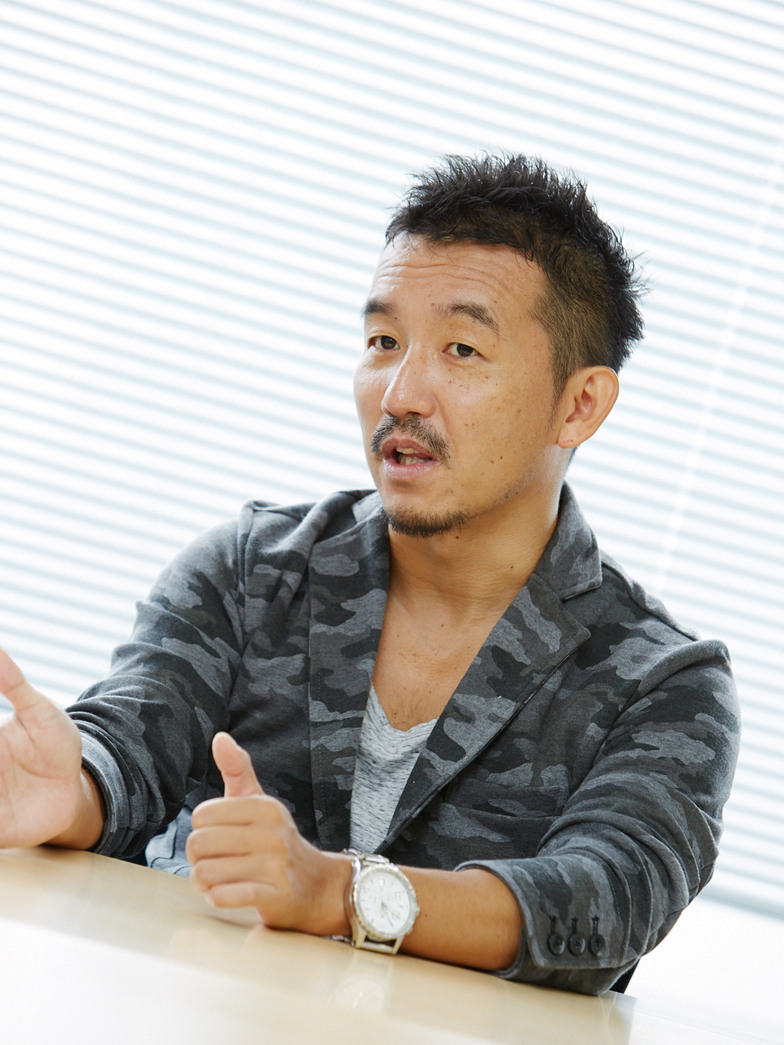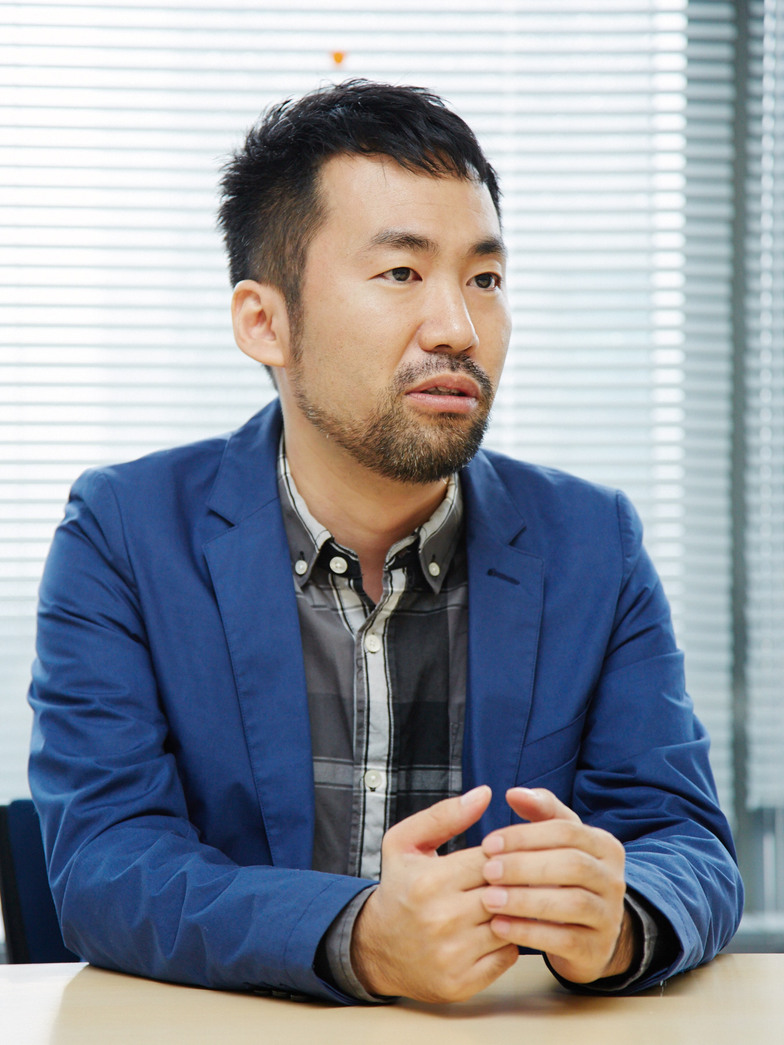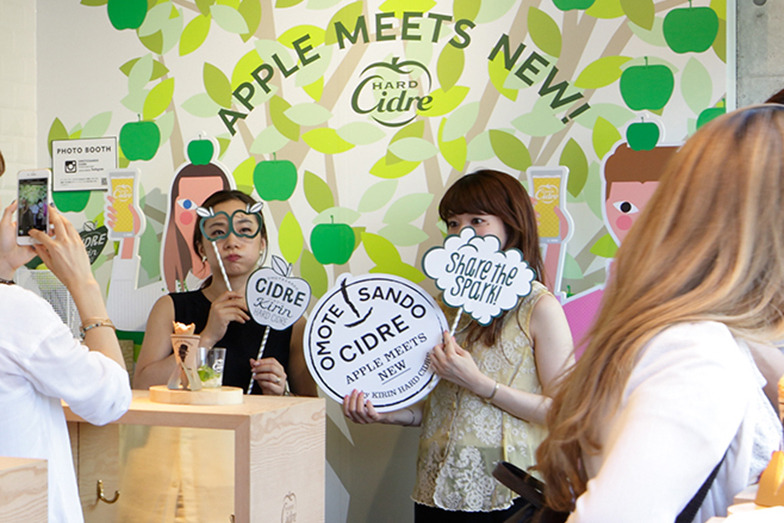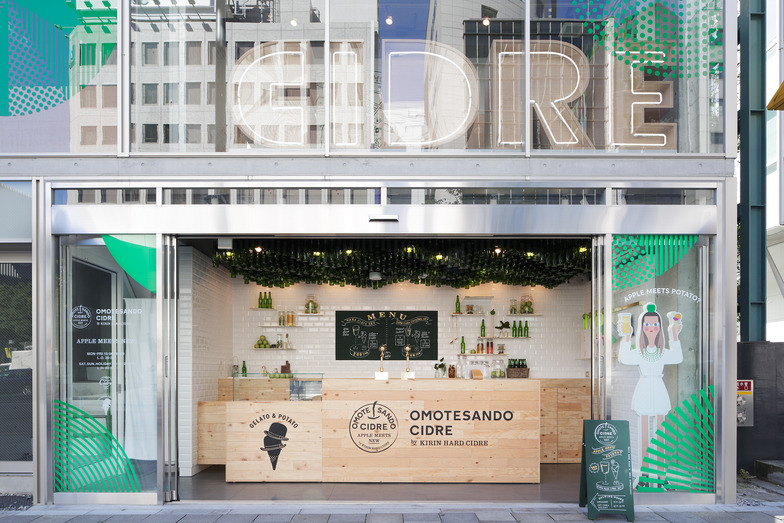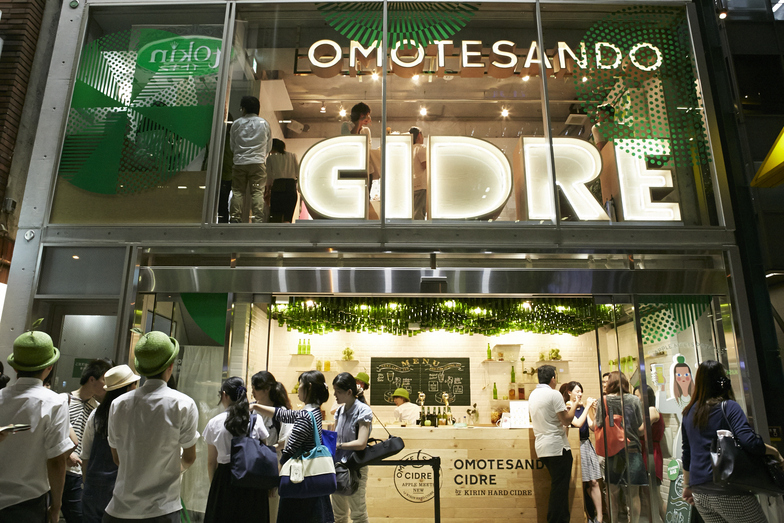From July 4th to August 22nd, Kirin Beer operated a charming pop-up store called "OMOTESANDO CIDRE by KIRIN HARD CIDRE" in Aoyama and Omotesando, Tokyo.
Masahiro Kai from Transit General Office (hereafter Transit), Yosuke Mamiya, Creative Director at Dentsu CDC, and Saori Koyama, Planner at Dentsu Inc. Event & Space Design Bureau, reflected on the project and shared their insights.
Taking on difficult challenges we've never done before, together with the client
Koyama: By the time I joined the planning phase, the pop-up store was already decided. Mamiya-san had proposed it during the annual promotion planning stage. Among the many solutions, could you share why you thought a pop-up store was best for Hard Cider?
Mamiya: There were two main reasons. First, this Hard Cider product isn't sold commercially; it's only available to drink in stores. As a product, it's exceptionally delicious, so we thought, "Seeing is believing," and wanted to create a place where people could easily try it.
Second, I wanted to break down internal organizational barriers and create something cross-functional. For instance, running a store involves proposing menus, communication strategies, spatial design, and event production. These are typically handled by different departments within the client, leading to fragmented goals. I wanted to create a unifying goal, like a school festival, where everyone could come together.
Koyama: I'm on the Event & Space Planning team. When we actually create a shop or event together, it brings us closer to the client. We set a goal and work together toward it, creating a real sense of unity.
Mamiya: For events lasting 3 to 5 days, you can get by with a hit-and-run approach, but the challenge this time was running the store for a month and a half.
Koyama: That's an incredibly long run for a pop-up store.
Mamiya: It truly felt like running an actual store, requiring expertise we didn't possess.
Koyama: That's why we reached out to Transit. I think Transit is exceptionally skilled at capturing target audience insights.
But Mr. Kai, you're an adult man, not the target demographic. How do you find things that appeal to young girls?
Kai: I consciously focus on "enhancing my feminine appeal" in my daily life (laughs). I make it a point to immediately check out anything that seems trendy or catches my interest.
We constantly share information internally, and leading that effort is our CEO, Sadahiro Nakamura. He often uses the terms "input" and "output" himself. He immediately shares the information he gains, not just internally but also externally. By sharing externally, we aim to build a reputation where people think, "This person has this kind of information; maybe they can help if I consult them." We all work together on this.
Koyama: Transit also has incredible PR power. It's about creating connections between people, or rather, it has a tremendous ability to attract the "desired customer base."
Kai: We make sure every store embodies a certain Transit essence, and we focus on influencers who resonate with our core target audience. So, we're always thinking about how to create spaces that attract those people.
Koyama: Lately, I feel like there's been a huge increase in companies wanting to get into cafes and food service, and we're getting a lot more consultations. Even manufacturers like apparel and automotive companies. Do you sense that at Transit too?
Kai: We get a lot of inquiries from people in completely different industries who have never done food and beverage before, wanting to get into it. We're seeing a significant increase in cases where we produce the store and also support its operation.
I think the era of just selling the product itself—like just selling clothes in fashion—is over. It's shifting toward proposing a lifestyle. Using food and beverage as a way to express a brand's worldview might be one method to lower the barrier to entry.
How to create a "world you want to photograph"
Koyama: This time, within the team, we placed huge importance not just on selling products, but on "communicating a style." Mamiya-san kept emphasizing that point throughout.
Whenever we started to drift off course, we always made sure to circle back to that point.
Mamiya: Right now, it's all about competing for the target audience's time. So first, we thought it was crucial to offer food and drink to secure more of their time. Beyond just placing products, the key this time was to communicate "style" by crafting the atmosphere and providing conversation starters that would make people fall deeper in love with the products.
Kai: When it comes to making people think "That's wonderful," while anything might resonate universally now, creating things and experiences that make people want to take photos is crucial. The photos customers share themselves gradually shape the brand's style.
Mamiya: As a client, I think there's a desire for the logo to appear in photos. But sometimes, when someone is about to take a photo and the logo suddenly pops up, they might just put their phone away.
That's a missed opportunity. So while respecting the client's wishes, we prioritize how to get people to take photos and how to make their experience enjoyable. That's what we learned from Transit when creating the space.
Koyama: We also put a lot of effort into encouraging photos. We created photo booths and props for people to play with. When you search "#hardcider" on Instagram, the vibe of the photos posted completely changed between before we opened and after. Now, customers are in the photos themselves, capturing the shop's atmosphere and the fun, lively mood. It was truly the customers' own posts that shaped the brand's style.
Mamiya: This shop was incredibly Instagram-worthy, wasn't it?

Customers enjoying photo shoots with props
Koyama: Speaking of style, this time we also developed merchandise and tabloids, and we paid meticulous attention to the details, right? Like the staff uniforms. Transit always has such stylish and great staff, don't they?
Kai: The Transit Crew team has hundreds of handsome guys and beautiful women on staff. That's part of their appeal. I think people are also an element of the space.
Koyama: We held events every Tuesday and constantly worked to keep things fresh from an information dissemination perspective.
Mamiya: For us, a month and a half felt incredibly long. There's this deep-seated fear at Dentsu Inc. that just having a store won't bring people in (laughs). We thought hard about how to get someone who visited once to come back, or how to give that final push to someone who was considering it but hadn't yet gone.
Koyama: We started with something like "Handsome Guy Night," where we took photos with foreign male models and gave them as gifts. We figured if people had a scene of themselves looking happy surrounded by handsome guys, they'd definitely want to post it on social media (laughs).

Handsome foreign models and customers
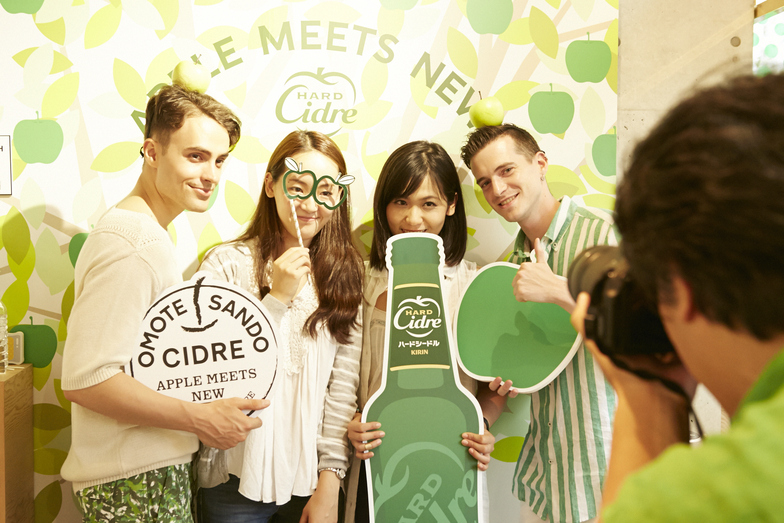
Mamiya: Next, we ran a promotion where we created a huge apple-shaped glass called the Big Glass, and if three or more people came together, it was free. It was like, "Come with your friends, have a lively time drinking, take pictures, and share them!"

The Big Apple Glass. Share and drink with three or more people.
Koyama: Hard Cider itself has the slogan "Share the Spark." You can create a scene where everyone sticks straws into a big apple glass and happily shares and drinks together.
We also held an event where people wearing something green could receive an original pouch from our store. We had Tokyo Hack, a group that usually performs as statues dressed entirely in white, dress entirely in green and check for green items. The Green Man stood out and attracted customers.
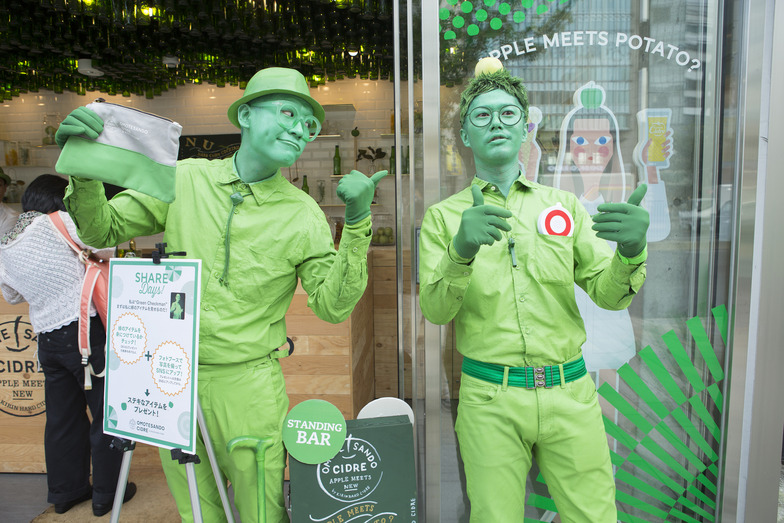
Tokyo Hack catches the eye of passersby
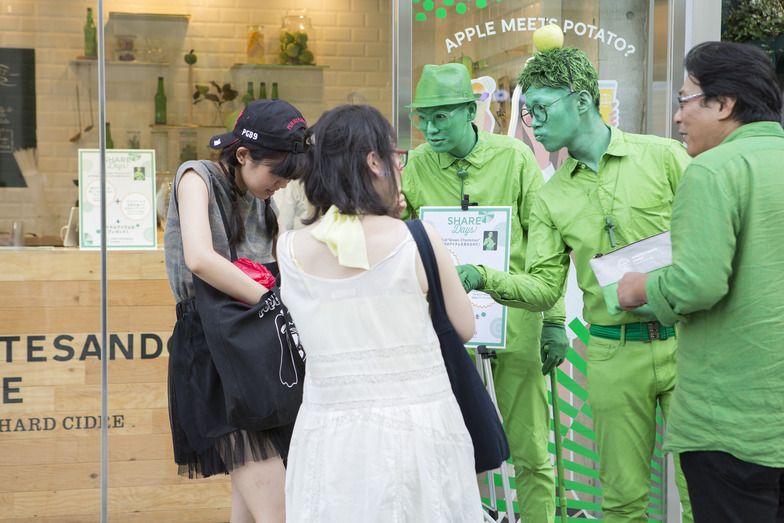
Aiming for an event space unlike any other and exceptional hospitality
Kai: This time, we actually thought about how we could leverage the limited space to our advantage. Creating a counter that makes the bar feel like it's right in front of you became a striking visual element this time, and I think it also served as a way to draw guests in.
Mamiya: I think the people drinking probably felt good too. You could look down on them from above.
Koyama: You rarely get to see Omotesando like that.
Mamiya: It's standing room only, and with so many people, the dwell time isn't that long, but I think the satisfaction level was high.
Koyama: And the gelato & potatoes were popular too.
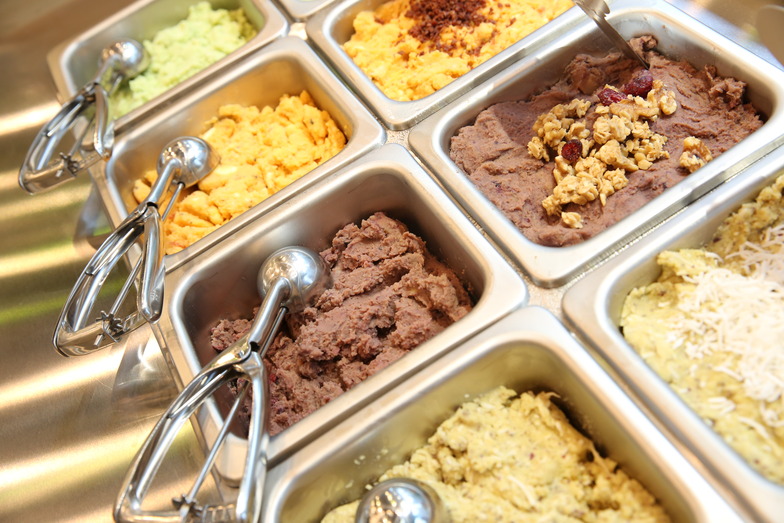
Gelato & Potato
Kai: First off, many people who see it for the first time come expecting it to be gelato. When they hear it's mashed potatoes, they're surprised and want to try it.
Koyama: I was worried that since it's summer, many might think, "Huh? It's not gelato? Then I'll pass," but the unexpected twist actually drew their interest.
Mamiya: Plus, eating the potato makes you thirsty, so the cider tastes amazing (laughs). Our clients tried it at the tasting and immediately understood. It was a fantastic collaboration. And the cocktails looked cute too.
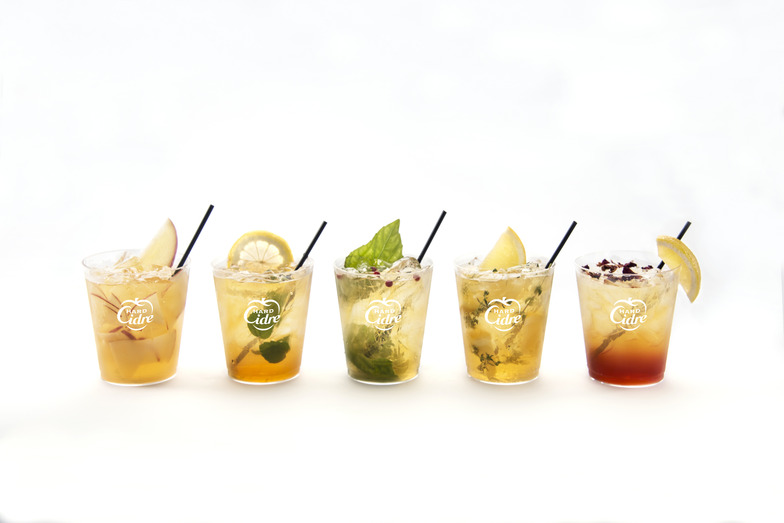
Cocktails using hard cider
Kai: The fact that we had repeat customers was really great. When we first talked with everyone, I kept insisting we shouldn't make it feel like an event, but rather focus on establishing our identity as a restaurant. By sticking to that, we got people who kept coming back as if it were a regular spot. Because the cocktails had variety, nearby residents started coming regularly, thinking, "Next time I'll try this one," or "The day after tomorrow I'll have that one."
Koyama: For the client, cocktails were a new venture too.
Mamiya: What I found interesting was looking at the sales numbers. At first, cocktail orders were high, but by the end, more people were drinking hard cider. If we'd only served hard cider, it probably wouldn't have generated that much buzz, and we wouldn't have had repeat customers. I realized how crucial it is to show that genuine hospitality—that attitude of truly wanting to entertain the people who come here.
Kai: Before reaching the enjoyment of drinking itself, the joy of choosing is absolutely essential. We made sure to approach it from that angle. Choosing a cocktail, choosing fries—it takes time, but spending that time helps customers get to know the products. It creates dialogue and communication between customers and staff.
Koyama: Seeing customers enjoy selecting items and spending time with us ultimately builds goodwill toward the brand. It made us happy too.
<End>




